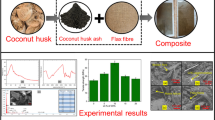Abstract
This study evaluated reinforcing effect of waste lignocellulosic material (bagasse) and nano-SiO2 powder on physical and mechanical properties of nano-biocomposites. In the specimen preparation, three levels of nano-SiO2 (0, 2, and 5 wt%) and 40 wt% of fibers were used. In order to increase the interphase adhesion, polyethylene grafted with maleic anhydride was added as a coupling agent to all composites studied. The results showed that while tensile, flexural, and hardness properties were moderately improved by adding bagasse fibers and increasing nano-SiO2 (NDS) content, Izod impact strength decreased dramatically, but fibers filled composite with 5 wt% nano-SiO2 showed similar impact strength value to pure HDPE specimen. Natural fibers and increasing levels of nano-SiO2 particles led to an upward trend for water absorption, while thickness swelling sharply increased and leveled off with adding these fillers. The results of study demonstrate positive effects of waste lignocellulosic material and nano-SiO2 particles on physical and mechanical properties of composites.




Similar content being viewed by others
References
Ashori A (2008) Wood–plastic composites as promising green-composites for automotive industries. Bioresour Technol 99(11):4661–4667
Ayora M, Rios R, Quijano J, Marquez A (1997) Evaluation by torque-rheometer of suspensions of semi-rigid and flexible natural fibers in a matrix of poly(vinyl chloride). Polym Compos 18(4):549–560
Ayrilmis N, Buyuksari U, Dundar T (2010) Waste pine cones as a source of reinforcing fillers for thermoplastic composites. J Appl Polym Sci 117(4):2324–2330
Bahadori H, Hosseini P (2012) Reduction of cement consumption by the aid of silica nano-particles (investigation on concrete properties). J Civil Eng Manag 18(3):416
Balasuriya PW, Ye L, Mai YW (2001) Mechanical properties of wood flake–polyethylene composites. Part I: effects of processing methods and matrix melt flow behavior. Compos A 32(5):619–629
Bledzki AK, Gassan J (1999) Composites reinforced with cellulose based fibres. Prog Polym Sci 24:221–274
Chiu FC, Yen HZ, Lee CE (2010) Characterization of PP/HDPE blend-based nanocomposites using different maleated polyolefins as compatibilizers. Polym Test 29(3):397–406
Dawson-Andoh B, Matuana LM, Harrison J (2004) Mold susceptibility of rigid PVC/wood-flour composites. J Vinyl Addit Technol 10(4):179–186
Dawson-Andoh B, Matuana LM, Harrison J (2005) Susceptibility of high-density polyethylene/wood-flour composite to mold discoloration. J Inst Wood Sci 17(2):114–119
De Rosa IM, Kenny JM, Puglia D, Santulli C, Sarasini F (2010) Morphological, thermal and mechanical characterization of okra (Abelmoschus esculentus) fibres as potential reinforcement in polymer composites. Compos Sci Technol 70(1):116–122
Deka BK, Maji TK (2010) Effect of coupling agent and nanoclay on properties of HDPE, LDPE, PP, PVC blend and Phargamites karka nanocomposite. Compos Sci Technol 70(12):1755–1761
Deka BK, Maji TK (2011) Effect of TiO2 and nanoclay on the properties of wood polymer nanocomposite. Compos A 42:2117–2125
Deka BK, Mandal M, Maji TK (2011) Study on properties of nanocomposites based on HDPE, LDPE, PP, PVC, wood and clay. Polym Bull. doi:10.1007/s00289-011-0529-5
Devi RR, Maji TK (2007) Effect of glycidyl methacrylate on the physical properties of wood–polymer composites. Polym Compos 28(1):1–5
Dikobe DG, Luyt AS (2007) Effect of poly(ethylene-co-glycidyl methacrylate) compatibilizer content on the morphology and physical properties of ethylene vinyl acetate–wood fiber composites. J Appl Polym Sci 104(5):3206–3213
Ding C, He H, Guo B, Jia D (2008) Structure and properties of polypropylene/clay nanocomposites compatibilized by solid-phase grafted polypropylene. Polym Compos 29(6):698–707
Gwon JG, Lee SY, Chun SJ, Doh GH, Kim JH (2010) Effects of chemical treatments of hybrid fillers on the physical and thermal properties of wood plastic composites. Compos A 41(10):1491–1497
Holbery J, Houston D (2006) Natural-fiber-reinforced polymer composites in automotive applications. JOM 58(11):80–86
Jiang H, Kamdem DP (2004) Development of poly(vinyl chloride)/wood composites. A literature review. J Vinyl Addit Technol 10(2):59–69
Joo YL, Cho MH (1999) Utilization of rheology control to develop wood grain patterned PVC/wood flour composites. Int Polym Proc 14:10–20
Kim HS, Lee BH, Choi SW, Kim S, Kim HJ (2007) The effect of types of maleic anhydride-grafted polypropylene (MAPP) on the interfacial adhesion properties of bio-flour-filled polypropylene composites. Compos A 38(6):1473–1482
Liang G, Xu J, Bao S, Xu W (2004) Polyethylene/maleic anhydride grafted polyethylene/organic-montmorillonite nanocomposites. I. Preparation, microstructure, and mechanical properties. J Appl Polym Sci 91(6):3974–3980
Malkapuram R, Kumar V, Yuvraj SN (2008) Recent development in natural fibre reinforced polypropylene composites. J Reinf Plast Compos 28:1169–1189
Malunka ME, Luyt AS, Krump H (2006) Preparation and characterization of EVA–sisal fiber composites. J Appl Polym Sci 100(2):1607–1617
Panthapulakkal S, Sain M (2007) Agro-residue reinforced high-density polyethylene composites: fiber characterization and analysis of composite properties. Compos A 38(6):1445–1454
Park ES (2008) Morphology, mechanical and dielectric breakdown properties of PBT/PET/TPE, PBT/PET/PA66, PBT/PET/LMPE and PBT/PET/TiO2 blends. Polym Compos 29(10):1111–1118
Pilarski JM, Matuana LM (2005) Durability of wood flour-plastic composites exposed to accelerated freeze–thaw cycling. Part I. Rigid PVC matrix. J Vinyl Addit Technol 11(1):1–8
Pilarski JM, Matuana LM (2006) Durability of wood flour-plastic composites exposed to accelerated freeze-thaw cycling. Part II. High density polyethylene matrix. J Appl Polym Sci 100(1):35–39
Salemane MG, Luyt AS (2006) Thermal and mechanical properties of polypropylene–wood powder composites. J Appl Polym Sci 100(5):4173–4180
Sombatsompop N, Chaochanchaikul K, Phromchirasuk C, Thongsang S (2003) Effect of wood sawdust content on rheological and structural changes, and thermo-mechanical properties of PVC/sawdust composites. Polym Int 52:1847
Sui G, Fuqua MA, Ulven CA, Zhong WH (2009) A plant fiber reinforced polymer composite prepared by a twin-screw extruder. Bioresour Technol 100(3):1246–1251
Yarahmadi N, Jakubowicz I, Hjertberg T (2010) Development of poly(vinyl chloride)/montmorillonite nanocomposites using chelating agents. Polym Degrad Stab 95(2):132–137
Acknowledgments
The authors gratefully acknowledge Department of Wood and Paper Science and Technology, Natural Resources Faculty, University of Tehran, Iran for the testing equipment used in this investigation. Further acknowledgement goes to Iran Polymer and Petrochemical Institute (IPPI) for the laboratory equipment used in the FRC panel manufacture.
Author information
Authors and Affiliations
Corresponding author
Rights and permissions
About this article
Cite this article
Hosseini, S.B., Hedjazi, S., Jamalirad, L. et al. Effect of nano-SiO2 on physical and mechanical properties of fiber reinforced composites (FRCs). J Indian Acad Wood Sci 11, 116–121 (2014). https://doi.org/10.1007/s13196-014-0126-y
Received:
Accepted:
Published:
Issue Date:
DOI: https://doi.org/10.1007/s13196-014-0126-y




